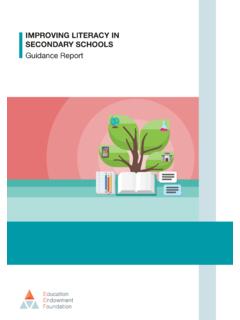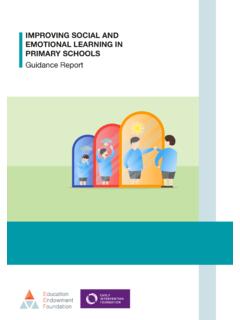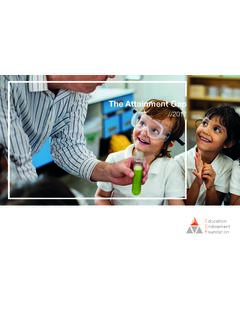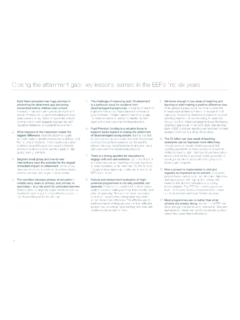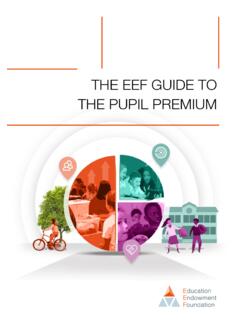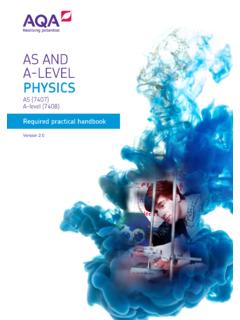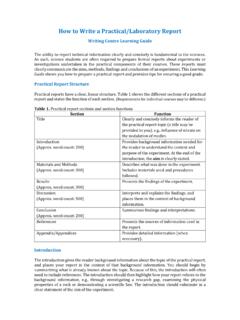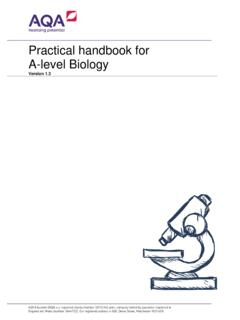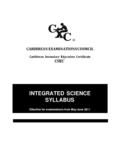Transcription of IMPROVING SECONDARY SCIENCE
1 Guidance ReportIMPROVING SECONDARY SCIENCE2 Education Endowment Foundation The authors would like to thank the many researchers and practitioners who provided support and feedback on drafts of this guidance. In particular we would like to thank the Advisory Panel and Evidence Review Group:Advisory Panel: Professor Judith Bennett (University of York), Lia Commissar (Wellcome Trust), Professor Harrie Eijkelhof (Universiteit Utrecht), Dr Niki Kaiser (Norwich Research School, Notre Dame High School), and Lauren Stephenson (Blackpool Research School, St. Mary s Catholic Academy).Evidence Review Group: Dr Andri Christodoulou, Professor Marcus Grace, Professor Janice Griffiths, Dr Carys Hughes, and Willeke Rietdijk (all University of Southampton).Peer Reviewers: Professor Michael J Reiss (UCL Institute of Education), and Professor Ian Abrahams (University of Lincoln)Guidance report authors: Sir John Holman (University of York) and Emily Yeomans (Education Endowment Foundation).
2 33 IMPROVING SECONDARY scienceForeword 4 Introduction 5 Teaching for engagement 7 Summary of recommendations 8 Recommendation 1 Preconceptions: Build on the ideas that pupils bring to lessons10 Recommendation 2 Self-regulation: Help pupils direct their own learning14 Recommendation 3 Modelling: Use models to support understanding18 Recommendation 4 Memory: Support pupils to retain and retrieve knowledge24 Recommendation 5 practical work : Use practical work purposefully and as part of a learning sequence28 Recommendation 6 Language of SCIENCE : Develop scientific vocabulary and support pupils to read and write about science32 Recommendation 7 Feedback: Use structured feedback to move on pupils thinking38 References and further reading 42 How was this guidance compiled?
3 46 CONTENTSS cience education is one of the keys to social mobility. SCIENCE qualifications open the doors to many rewarding and interesting careers, and scientific literacy is critically important to being an informed citizen. SCIENCE is the most powerful method humans have for understanding the world, and SCIENCE teachers in SECONDARY schools lay the foundations of that understanding. When asked why they chose to continue their study of SCIENCE , most pupils mention an inspiring anyone understands the importance of evidence, it is SCIENCE teachers. There is no shortage of research evidence about good SCIENCE teaching, but few teachers have time to read it and sometimes it is difficult to unpick the implications for classroom practice. This report gives accessible guidance for SCIENCE teachers that is based on robust evidence. We have looked at seven areas which our expert advisers told us are particularly important for successful SCIENCE teaching, and we set out to find what the research evidence tells us about each.
4 We commissioned evidence reviews to see what the research literature says, and our expert advisers helped us to identify the parts of these reviews that could make most difference to teaching. We then consulted teacher panels to see if our suggestions made sense in today s classrooms. Much of what we have to say about literacy, memory and feedback, for example is applicable to teaching in many subjects. But in this report we have set the guidance in the context of SECONDARY SCIENCE , and drawn all our examples from are very grateful to the many researchers and practitioners who provided support and feedback on drafts of this guidance. In particular we would like to thank our expert advisers and evidence reviewers, whose names are on page John Holman University of YorkThe attainment gap in SCIENCE may not be as well-documented as the gap in English and maths, but it is just as pervasive. Our research has shown that disadvantaged pupils start to fall behind in SCIENCE in Key Stage 1; the gap only gets wider throughout primary and SECONDARY school and on to A-level.
5 Helping schools to use evidence and to understand better the most effective ways to improve results is the best way to tackle this country s stark SCIENCE attainment is why we ve produced this guidance report. It offers seven practical evidence-based recommendations that are relevant to all pupils, but particularly to those struggling with SCIENCE . To develop the recommendations we reviewed the best available international research and consulted experts to arrive at key principles for effective SECONDARY SCIENCE with all our guidance reports, the publication is just the start. We will now be working with the sector, including through our colleagues in the Research Schools Network, to build on the recommendations with further training and resources. And, as ever, we will be looking to support and test the most promising programmes that put the lessons from the research into hope is that this report and our whole series of guidance reports - will help to support a consistently excellent, evidence-informed education system in England that creates great opportunities for all children, regardless of their family Kevan Collins Chief Executive Education Endowment Foundation4 Education Endowment Foundation FOREWORD5 INTRODUCTION5 IMPROVING SECONDARY scienceWho is this guidance for?
6 This guidance is for SECONDARY SCIENCE teachers, heads of SCIENCE departments, and senior leaders. The recommendations are designed to be actionable by classroom teachers, but there is benefit in teachers coming together as a department to think about how it applies in their context. What does this guidance cover?This guidance report is relevant to the teaching of SCIENCE at Key Stages 3 and 4. We have focused on the seven areas where the evidence provides the strongest steer about how to enhance the teaching of SCIENCE to pupils in this age group and have provided examples of how to apply the recommendations in practice. Each recommendation provides a First stop for further reading for teachers who want to find out more about the evidence underpinning the recommendations. In addition to the seven areas, we provide guidance on the overarching theme of teaching for engagement, something which is particularly important for SCIENCE in SCIENCE education has a strong history in areas such as teaching difficult ideas in SCIENCE , language in SCIENCE lessons, and ways of engaging pupils with what they are learning in their lessons.
7 However, there are also important messages from research about learning more generally, such as in the area of memory and strategies for IMPROVING self-regulated learning. Evidence-informed SCIENCE teaching is not about fitting more into a tight timetable: it s about using limited time and resources as smartly as possible, by focusing on what is most likely to have a positive impact. Many of the suggestions in this guidance report will be familiar to you from your own experience and practice. We have used the research evidence to show how some of the things you already do can be as effective as possible, as well as some ideas which may be new to your practice. Take practical work , for example. Many of your lessons will involve practicals: in this report we summarise what the research says about how to get the most out of your lab time by being clear about its purpose and sequencing it with other learning activities. SCIENCE is exceptional among school subjects in the number of organisations that provide support for teachers, often free of charge 6 Education Endowment Foundation INTRODUCTIONType of organisationExample organisationsExamples of supportCharitable foundationsWellcome TrustGatsby FoundationThe Chartered College of TeachingResearch reportsSupport for teachers CPDI ndustry and businessBPGSKBAe SystemsRolls RoyceResources for pupilsSupport for teachers CPDO utreach, especially STEM AmbassadorsProfessional bodies and subject associationsAssociation for SCIENCE EducationRoyal Society of BiologyInstitute of PhysicsRoyal Society of ChemistryRoyal SocietyJournalsTeachers CPDA dvice for teachersResources for pupilsFurther and higher educationUniversitiesColleges of FEOutreach by staff and student ambassadorsTable 1.
8 Types of organisation supporting SCIENCE education with examplesActing on the guidanceScience teaching involves supporting both the language and mathematical development of pupils and there is a lot to be gained by working with your colleagues from maths and English departments. More information on best practice teaching of maths and literacy can be found in the EEF s published report IMPROVING Mathematics in Key Stages 2 and 3 and the EEF s upcoming report on literacy in SECONDARY schools. The more general EEF guidance, such as Putting Evidence to work A School s Guide to Implementation, can also support you and senior staff in your school to apply the recommendations. You may also want to seek support from our national network of Research Schools, a collaboration between the EEF and the Institute for Effective Education.* A CPD course based on the recommendations from this report will be available from the Research School s is also a wealth of support in addition to that provided by the EEF, and SCIENCE is exceptional among school subjects in the number of organisations that provide support for teachers, often free of charge.
9 Support may be in the form of CPD for teachers, resources for pupils, or outreach activities. The range of organisations supporting SCIENCE teaching can be bewildering, but a good place to start finding out what is available is the National STEM Learning Centre, The broad categories of STEM-supporting organisations are summarised in Table 1. CPD does not have to be provided by external organisations and you can keep your own knowledge of research evidence up to date by using sources which are quickly and easily read, such as Best Evidence in Brief from the Institute for Effective Education and Impact, the journal of the Chartered College of Teaching.* 7 IMPROVING SECONDARY scienceGood teaching begins with gaining pupils engagement and winning their commitment to learn. SCIENCE teaching is not just about getting good results at GCSE, important though that is; every SECONDARY teacher knows the deep satisfaction that comes from lighting the fires of interest in young people and stimulating them to take a particular subject further.
10 A considerable body of evidence now identifies the quality of teaching as a major determinant of pupil engagement and Good SCIENCE teaching improves both attainment and engagement, and all of the recommendations in this report should therefore support positive attitudes to SCIENCE . But there is an engagement problem in SCIENCE . Many pupils feel that SCIENCE is important, but not for m e .2 They know SCIENCE is powerful, but they do not see its relevance to their lives and they don t believe that people like them go on to study SCIENCE . This is an issue that starts young and worsens through compulsory schooling, with attitudes declining from the age of five onwards;3 interest in pursuing further study in SCIENCE is largely formed by the age of A major study of attitudes towards SCIENCE (ASPIRES) has shown that pupils who aspire to study SCIENCE subjects are more likely to have high levels of SCIENCE capital .5 There are eight key dimensions of SCIENCE capital these include a pupil s SCIENCE -related attitudes, their knowledge about the transferability of SCIENCE , their participation in out-of-school SCIENCE contexts, and the SCIENCE skills and qualifications of their Knowledge about the features that lead to high engagement with SCIENCE has led to the development of a SCIENCE Capital Teaching Approach.
